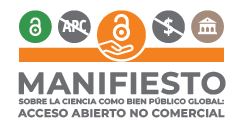Integration of Information and Communication Technologies in the Consultations of the Blended Modality. Case: Miguel de Cervantes University
Keywords:
integration of technologies, semi-face-to-face education, information and communication technologyAbstract
This article contains a set of reflections related to the integration of information and communication technologies (ICT) in the advice provided in the semipresence academic programs of the Miguel de Cervantes University (UMC), Chile. For this, an analysis work was carried out, as a result of interviews with authors of innovative projects presented and disseminated in the University’s media and events. In the final considerations it is highlighted that the university, through the staff with desires and willingness to innovate, from the different competent instances, stimulates and considers the initiatives developed with the purpose of generating significant changes in the distance education model.
Downloads
References
Barragán, Miguel (2014). Epistemología. Editorial Santo Tomas de Aquino. Bogotá, Colombia.
Becerra, José (1993). Innovación tecnológica y desarrollo regional: hacia una más eficaz interrelación universidad-sociedad. Revista Estudios Regionales. Volumen 36: Pp. 365-385.
Del Moral, Eduardo (2014). Oportunidades de las TIC para la innovación educativa en las escuelas rurales de Asturias. Revista Aula Abierta, Volumen 42, No. 1: Pp. 61-67.
El Mercurio (2017). La educación online es una tendencia y oportunidad para las personas y las instituciones. Diario El Mercurio. Ediciones Especiales. Santiago de Chile, Chile.
García, Luis (2004). Algunos modelos de educación a distancia. Documento en línea. Disponible en: http://www.uned.es/catedraunesco-ead/editorial/p7-11-2004.pdf. Consulta: 15/12/2015.
Hinojo, María y Fernández, Andrés (2012). El aprendizaje semipresencial o virtual: nueva metodología de aprendizaje en educación superior. Revista Latinoamericana de Ciencias Sociales, Niñez y Juventud. Año 10, No. 1: Pp. 159-167.
Kearsley, Gerson (2000). Online Teaching: Learning and Teaching in Cyberspace. Wadsworth Publishing. Alberta, Canadá.
Magro, Carlos (2014). La aventura del saber. Entrevista realizada por: M. J. García. Documento en línea. Disponible en: http://www.rtve.es/alacarta/videos/la-aventura-del-saber/aventura-del-saber-carlos-magro/2481857/. Consulta: 08/10/2016.
Piñeiro, Teresa (2012). Los podcasts en la educación superior. Hacia un paradigma de formación intersticial. Revista Iberoamericana de Educación. Volumen 58, No. 1: Pp. 1-12.
UNESCO (1990). Declaración Mundial sobre Educación para Todos. Documento en línea. Disponible en: http://unesdoc.unesco.org/images/0012/001275/127583s.pdf. Consulta: 20/07/2019.
UNESCO (2009). Conferencia Mundial: La nueva dinámica de la educación superior y la investigación para la transformación social y el desarrollo. Informe final. París, Francia.
Velásquez, Blanco (2013). Los medios complementarios en el área de Ingeniería de la Universidad Nacional Abierta. En Universidad Nacional Abierta (Ed.). Educación a Distancia en la Universidad Nacional Abierta de Venezuela. Ediciones del Rectorado. Caracas, Venezuela. Pp. 213-223.
Downloads
Published
How to Cite
Issue
Section
License
Copyright (c) 2019 Universidad Alonso de Ojeda

This work is licensed under a Creative Commons Attribution-NonCommercial-ShareAlike 4.0 International License.
All content of Ethos Journal will be free access, distributed under the Creative Commons license (BY-NC-SA).




